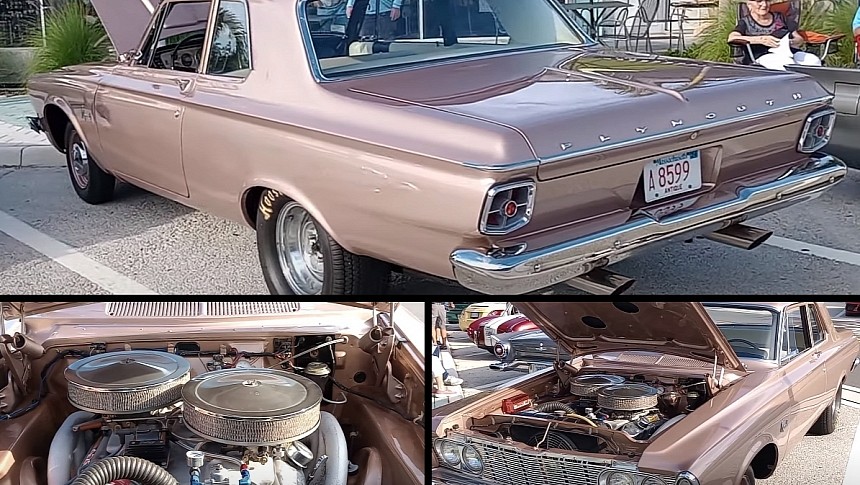Initially introduced on a station wagon in 1951, the Savoy name received stand-alone nameplate privileges in 1954. That's when it became Plymouth's mid-range full-size car, slotting between the base Plaza and the top-of-the-line Belvedere.
This affair continued until 1959, when Plymouth discontinued the Plaza and relegated the Savoy to entry-level duty. The nameplate retained its role through 1964, when the company sent the nameplate into the history books.
All told, the Savoy is not a historically significant Mopar at first glance. At least not as far as the classic car market is concerned. However, the nameplate did spawn an unassuming muscle car that's worth talking about. It all happened between 1962 and 1964. That's when Plymouth produced the final iteration of the vehicle for the midsize market.
In 1962, the company downsized its entire full-size range, moving the Belvedere, Fury, and Savoy into the intermediate segment. The move was somewhat controversial at the time, and Chrysler sales slumped in a market that still adhered to the "bigger is better" slogan. But the smaller and lighter body made these cars popular among drag racers.
And as soon as the Belvederes and Savoys (and their Dodge counterparts) began posting solid quarter-mile times, Chrysler stepped in to offer high-performance upgrades and even a factory dragster. The latter got the Max Wedge V8, the predecessor to the more iconic 426-cubic-inch (7.0-liter) HEMI.
Known as the Super Stock in Plymouths and the Ramcharger in Dodges, the Max Wedge debuted in 1962 as a 413-cubic-inch (6.9-liter) mill based on the RB-block V8. It generated 410 or 420 horsepower, depending on the compression ratio. The engine was enlarged to 426 cubic inches, and output increased to 415 or 425 horses in 1963. Chrysler discontinued the Max Wedge in 1964 when it rolled out the race-spec HEMI.
Not only short-lived, the Max Wedge was also produced in small numbers. In 1962, for instance, only 512 vehicles were fitted with the mill. The figure includes all Dodge and Plymouth nameplates, so we're talking about tens of examples each. And because many of these rigs were raced and wrecked, very few have survived to see 2023.
The 1963 Plymouth Savoy you see here is one of those cars. And if we are to believe our host, it's a one-owner, "real deal" vehicle. And these details turn it into a Mopar many of us will never see in the metal.
Is it one of those all-original and unmolested survivors? Not really. The orange Max Wedge block is surrounded by a few replacement components with a more modern touch, and the paint looks too fresh, but this doesn't mean it's not an authentic Super Stock Mopar. The car seems legit overall and is as rare as they get. That's because Plymouth dropped the 426-cubic-inch Max Wedge in only 18 Savoy cars for the 1963 model year. Hit the play button below to check it out.
All told, the Savoy is not a historically significant Mopar at first glance. At least not as far as the classic car market is concerned. However, the nameplate did spawn an unassuming muscle car that's worth talking about. It all happened between 1962 and 1964. That's when Plymouth produced the final iteration of the vehicle for the midsize market.
In 1962, the company downsized its entire full-size range, moving the Belvedere, Fury, and Savoy into the intermediate segment. The move was somewhat controversial at the time, and Chrysler sales slumped in a market that still adhered to the "bigger is better" slogan. But the smaller and lighter body made these cars popular among drag racers.
And as soon as the Belvederes and Savoys (and their Dodge counterparts) began posting solid quarter-mile times, Chrysler stepped in to offer high-performance upgrades and even a factory dragster. The latter got the Max Wedge V8, the predecessor to the more iconic 426-cubic-inch (7.0-liter) HEMI.
Known as the Super Stock in Plymouths and the Ramcharger in Dodges, the Max Wedge debuted in 1962 as a 413-cubic-inch (6.9-liter) mill based on the RB-block V8. It generated 410 or 420 horsepower, depending on the compression ratio. The engine was enlarged to 426 cubic inches, and output increased to 415 or 425 horses in 1963. Chrysler discontinued the Max Wedge in 1964 when it rolled out the race-spec HEMI.
Not only short-lived, the Max Wedge was also produced in small numbers. In 1962, for instance, only 512 vehicles were fitted with the mill. The figure includes all Dodge and Plymouth nameplates, so we're talking about tens of examples each. And because many of these rigs were raced and wrecked, very few have survived to see 2023.
The 1963 Plymouth Savoy you see here is one of those cars. And if we are to believe our host, it's a one-owner, "real deal" vehicle. And these details turn it into a Mopar many of us will never see in the metal.
Is it one of those all-original and unmolested survivors? Not really. The orange Max Wedge block is surrounded by a few replacement components with a more modern touch, and the paint looks too fresh, but this doesn't mean it's not an authentic Super Stock Mopar. The car seems legit overall and is as rare as they get. That's because Plymouth dropped the 426-cubic-inch Max Wedge in only 18 Savoy cars for the 1963 model year. Hit the play button below to check it out.









